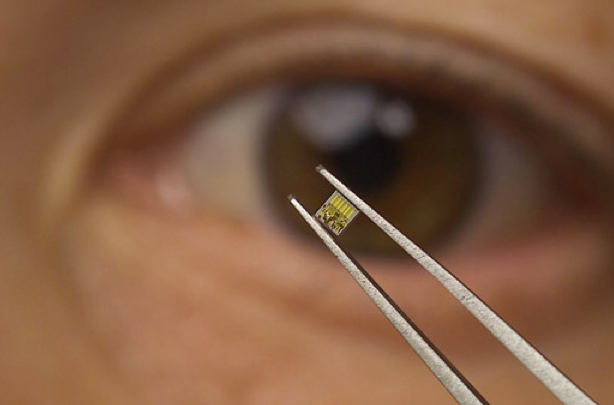21st Century Wire says…
Every crisis gives birth to a new solution – and the technology, GMO and Pharma industries have taken this idea to religious levels.
But what price are we paying for riding along with these industries? Technology is moving so quickly that the population have become one giant commercial experiment in the new global crusade for efficiency and convenience (and profits).

DARPA and IBM claim they want to “fix the plumbing” of our clogged-up mobile data networks, as they unveil their new millimeter wave-length radio frequency relay stations powered by their new super “Geranium” chip technology.
It is unknown as yet what effects their new millimeter-wave wireless communication links will have on humans. Similar technology has already been deployed by the TSA in America through their body scanners which also use radiation-emitting microwave technology – devices which were quickly rolled out without being independently tested on animals, or humans for safety. In the case of full body scanners that use high frequency waves, it has been shown that this millimeter wavelength technology can unzip and disrupt human DNA structures.
So what about the ultra low frequency wave spectrum which DARPA andf IBM plan to deploy on the population to help “unblock” our alleged clogged-up mobile data networks?
Smart meters also use low-energy radio frequency waves to transmit information over long distances, a questionable technology which has already reaped a serious public backlash over its potential health risks. Public action on this issue has slowed down the roll out of smart meters, for now.
But the risks of bathing the population in even more microwaves by harnessing an entirely new portion of the radio wave spectrum – all in order to speed up our iPhone and Android performance, is maybe something humanity should not rush into either.
Much more long-term research and debate must be done on the effects of RF’s and EMF’s on humans, animals, insects and their environment, but US defense giants DARPA, along with IBM, Apple, Samsung, AT&T, Verizon, Vodaphone and the rest – appear unwilling to want to wait and study the ramifications because they are all in a race to get their technology to market. Was is their long-term plan for increasing our daily doses of radiation? Do they even have a plan? Their plan is to shift units.
Are we all merely human guinea pigs then?
You decide, but don’t wait too long…
.
IBM’s new radio chips could help unclog wireless data networks
Dean Takahashi
Venture Beat
IBM has been pushing the limits on its hybrid silicon germanium chip technology for years, and next Tuesday it is announcing the fifth generation of the technology that is aimed at relieving communications bottlenecks.
As consumers and carriers try to jam more data over wireless networks, the network is getting clogged. To fix the plumbing with the technical equivalent of a plunger, IBM is creating its 9HP silicon germanium chip technology. And in a separate announcement, IBM researchers have also made a breakthrough in millimeter-wave radio technology. Together, both technologies could lead to fast mobile data networks.
The chips could be used to help mobile carriers move data through their networks. It could be used in applications such as WiFi, LTE cellular, wireless backhaul, and high-speed optical communications.
IBM has been developing silicon germanium chips — which fuse two different elements together, unlike the traditional silicon chips — since 1995. That has spurred a revolution in radio frequency performance, which, in turn, has led to wireless breakthrough technologies such as satellite global positioning systems, WiFi radios, and high-speed optical links. The new 9HP technology is a process in a chip factory that allows chip designers to take advantage of faster and more power-efficient components.
Those designers can create technologies such as millimeter-wave wireless communication links. IBM will unveil the technologies at the IEEE Radio Frequency Integrated Circuit Symposium in Seattle next Tuesday.
“Silicon-germanium is one of the key technologies that have enabled wireless operators to keep up with the explosive growth in data traffic generated from mobile handsets,” said David Harame, an IBM Fellow. “Before silicon germanium, the high-performance chips used in base stations and optical links were built using expensive, esoteric processes. Silicon germanium provides that performance as well as integration and cost savings” because it uses conventional manufacturing technology.
Customers such as Semtech and Tektronix are using the silicon germanium technology to create wireless equipment.
IBM engineers have also created a millimeter wave transceiver for mobile communications and radar imaging applications. That transceiver brings together four different chips in a single package. The millimeter wave technology takes advantage of under-utilized low-frequency parts of the wireless spectrum. It can be used in the infrastructure for mobile networks in categories such as mobile back-haul, small cell infrastructure, and data center overlay network deployment.
The work was partly funded by the Defense Advanced Research Projects Agency (DARPA) Strategy Technology Office.
READ MORE DARPA NEWS AT: 21st Century Wire DARPA Files















